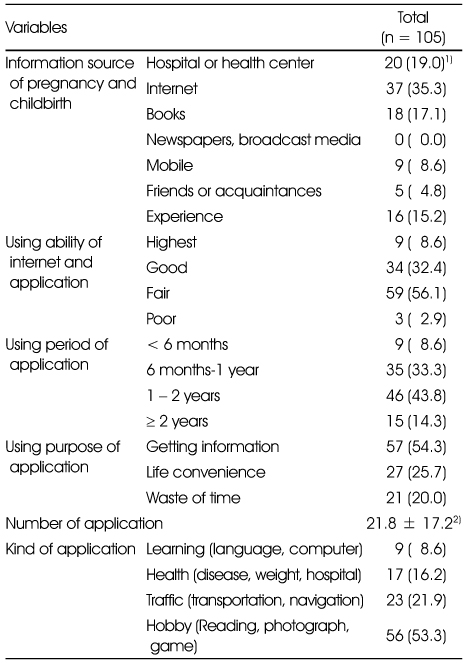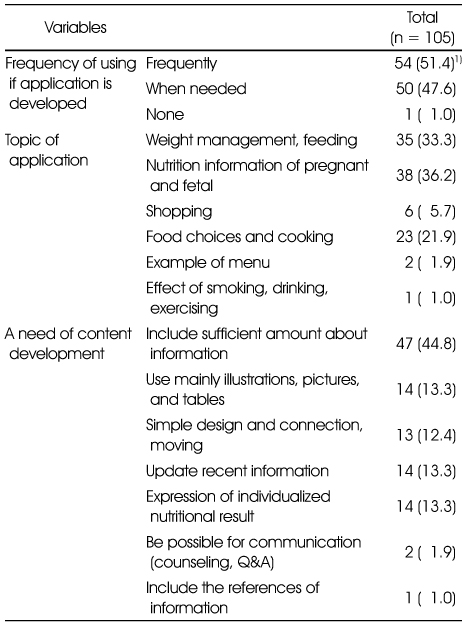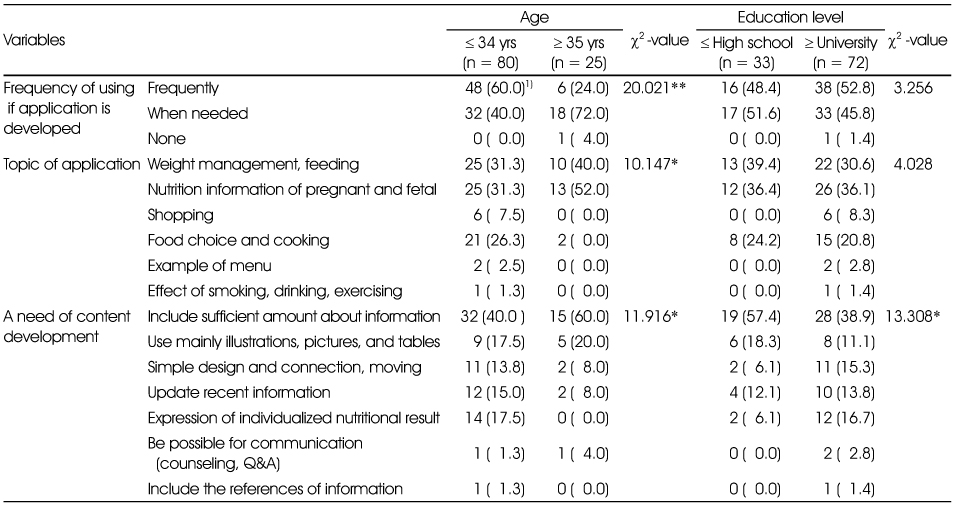Articles
- Page Path
- HOME > Korean J Community Nutr > Volume 18(6); 2013 > Article
-
Original Article
- A study on Consumer's Needs for Development of Diet Guide Application for Pregnant Women
- Sook-Bae Kim, Jeong-Weon Kim, Mi-Hyun Kim, Young-Sook Cho, Se-Na Kim, Hee-Sook Lim, Soon-Kyung Kim
-
Korean Journal of Community Nutrition 2013;18(6):588-598.
DOI: https://doi.org/10.5720/kjcn.2013.18.6.588
Published online: December 31, 2013
Department of Food Science and Human Nutrition, Research Institute of Human Ecology, Chonbuk National University, Jeonju, Korea.
1Department of Science & Technology Education for Life, Seoul National University of Education, Seoul, Korea.
2Department of Food and Nutrition, Korea National University of Transportation, Chungbuk, Korea.
3Department of Agrofood Resources, NAAS, RDA, Suwon, Korea.
4Department of Nutrition, Soonchunhyang University Bucheon Hospital, Korea.
5Department of Food Sciences and Nutrition, Soonchunhyang University, Asan, Korea.
- Corresponding author: Soon-Kyung Kim, Dept of Food Sciences & Nutrition, Soonchunhyang University, Asan 336-746, Korea. Tel: (041) 530-1261, Fax: (041) 530-1264, soon56@sch.ac.kr
Copyright © 2013 The Korean Society of Community Nutrition
This is an Open-Access article distributed under the terms of the Creative Commons Attribution Non-Commercial License (http://creativecommons.org/licenses/by-nc/3.0/) which permits unrestricted non-commercial use, distribution, and reproduction in any medium, provided the original work is properly cited.
- 482 Views
- 2 Download
- 6 Crossref
Abstract
- This study was conducted to assess needs of educational mobile application (App) development for nutritional management and information on pregnant women. A total of 105 pregnant women were investigated on general characteristics, dietary habits, health behavior and needs for contents and composition of the application. The mean age of the subjects was 31.9 years and the mean gestation period was 25.4 weeks. The rate of skipping meal was 39.0% and the rate of irregular meal time was 46.6%. The consciousness of the meal as balanced nutrition and health was 19.9%. Eating out at least forth a week was 35.3%. Obtaining information about pregnancy and childbirth were internet (35.3%), hospital or health center (19.9%), books (17.1%), experience (15.2%), mobile (8.6%) and friends or acquaintances (4.8%). If the application is developed, subject replied 'frequently use' (51.4%), 'when needed' (47.6%) respectively. The favour topic in developing application were 'nutrition information of pregnant and fetal' (36.2%), 'weight management, feeding' (33.3%), 'food choice and cooking' (21.9%), 'shopping' (5.7%), 'example of menu' (1.9%), 'effect of smoking, drinking, exercising' (1.0%). The favorite content was 'include sufficient amount about information' (44.8%). Depending on the age and education level, the best age for pregnancy group have significantly higher ability for utilize and information gathering than old age pregnant group. Also the best age for pregnancy group have high demands of design, convenience and various contents in App development. Therefore, mobile application (App) for pregnant women could be widely used as an effective dietary guide.
-
This research was supported by a grant (PJ008237) from Rural Development Administration in 2012 for the development of national information system on nutrition and functionality of food and Research funds of Soonchunhyang University.
NOTES
- 1. Abu-Saad K, Fraser D. Maternal nutrition and birth outcomes. Epidemiol Rev 2010; 32: 5-25.ArticlePubMed
- 2. Ahn HS, Lee YM, Oh Yj. Perception and service needs about nutrition education of pregnant and lactating -to compare with pregnant and lactating women, health specialist and college women. Korean J Community Nutr 2006; 11(3): 327-337.
- 3. Cho JH, Kim SB, Kim SK, Kim MH, Kim GS, Kim SN, Kim SY, Kim JW. Development of 'children's food avatar' application for dietary education. Korean J Community Nutr 2013; 18(4): 299-311.Article
- 4. Choi BS, Lee IS, Shin JJ, Lim WK, Park MH. Factors affecting dietary & nutrients intake during the first, second, and third trimesters and pregnancy outcome. Korean J Diet Cult 2001; 16(3): 203-214.
- 5. Choi HM. Nutrition in pregnancy. Korean J Obstet Gynecol 2008; 51(5): 481-491.
- 6. Choi JH, Han HJ, Hwang JH, Chung SR, Moon HM, Moon IP, Cha KJ, Choi HS, Oh JE. Meta analysis of clinical studies of pregnancy and delivery in elderly gravida. Korean J Obstet Gynecol 2006; 49(2): 293-308.
- 7. Christian P, Khatry SK, Katz J, Pradhan EK. Effects of alternative maternal micronutrient supplements on low birth weight in rural Nepal: double blind randomized community trial. BMJ 2003; 326(7389): 571-576.
- 8. Gartner. Gartner says android to become No. 2 worldwide mobile operating system in 2010 and challenge symbian for No. 1 position by 2014. 2010; cited 2010 September 1]. Available from http://gartner.com/it/page.jsp?id=1434613.
- 9. Han JS, Jeong JH. A web-based internet program for nutritional counseling and diet management of patient with diabetes mellitus. J Korean Soc Food Sci Nutr 2004; 33(1): 114-122.
- 10. Han YS, Lee SS. Association of nutrient intake and pregnancy outcome with gestational weight gain. Korean J Nutr 2010; 43(2): 141-151.
- 11. Health Insurance Review and Assessment Service. Evaluation and follow up report on cesarean section in Korea. 2009.
- 12. Ibrahim M, Forsyth S. Nutritional interactions between mother and fetus. Pract Midwife 2002; 5(10): 10-17.
- 13. Joung HJ, Choi BS, Chin JJ, Yoon SD, Yoon H. The dietary intake of pregnant women in Daegu area. Korean J Community Nutr 2003; 8(4): 538-546.
- 14. Kim IS. A nutrition survey and development of supplemental programs for women, infants and children. Daegu University; 2007; 6. MS thesis.
- 15. Kim JE, Park DY. A study on the actual conditions and needs for nutrition education for pregnal women in health center. Korean J Community Living Sci 2007; 18(4): 687-698.
- 16. Kim YJ, Ryou HJ, Nam HJ, Min YH, Park HR. Development and assessment of maternal and child nutrition educationmaterials for health center use. J Korean Diet Assoc 2004; 10(4): 428-441.
- 17. Korea Internet and Security Agency. Analysis for domestic customers of internet service. 2012; cited 2013 June 9]. Available from http://www.kisa.or.kr/notice/pressView.jsp?mode=view&pNo=8&bNo=8&bNo=1040.
- 18. Korea National Statistical Office. Annual report on the trend of death and birth statistics 2010. Seoul: 2011; cited 2012 september 20]. Available from http://kosis.kr/statisticsList/statisticsList01List.jsp?vwcd=MT ZTITLE&parmTabid=M0101.
- 19. Koo J, Choi K. Status and needs for nutrition services for infants and preschoolers among public health center workers and infants mothers. Korean J Community Nutr 2001; 6(3): 354-360.
- 20. Lee KH, Her ES. A Study on the Development of a computer-assisted program for elementary school foodservice(I). Korean J Community Nutr 2000; 5(2): 208-216.
- 21. Lee SL, Chang YK. A study of health related factors and food habits during pregnancy of full-term and preterm delivery. J Korean Diet Assoc 2008; 14(1): 77-86.
- 22. Lhm JH, Kim HW, Kim YS. A study of the monthly weight gains of noncomplicated pregnancies. Korean J Perinatol 2002; 13(2): 135-140.
- 23. Moon JY, Hahn WH, Shin KS. Changes of maternal age distribution in live births and incidence of low birth weight infants in advanced maternal age group in Korea. Korean J Perinatol 2011; 22(1): 30-36.
- 24. Park JC, Hwang DG, Park KS, Lim KA. Design and implamentation of diabetes management system based in PDA in the wireless internet enviroment. J Korea Academic-Industrial Cooperation Soc 2007; 8(6): 1513-1518.
- 25. Park JH, Kim SB, Cho KH, Choue RW. Maternal nutritional status at the end of pregnancy, and correlation among pregnancy weight gain, birth weight and serum leptin levels. Korean J Nutr 2006; 39(5): 467-475.
- 26. Siega-Riz AM, Herrmann TS, Savitz DA, Thorp JM. Frequency of eating during pregnancy and its effect on preterm delivery. Am J Epidemiol 2001; 153(7): 647-652.
- 27. Seo YM, Lee YJ. Analysis of educational smartphone applications and mobile educational services trends. J Korean Assoc Comput Educ 2010; 14(2): 9-13.
- 28. Shin SY. A study on the effect of personal characteristics and the innovative service characteristics of Smartphones on receptive attitude. Hong-Ik University; 2010; 1-48 MS thesis.
- 29. Swensen AR, Harnack LJ, Ross JA. Nutritional assessment of pregnant women enrolled in the special supplemental program for women, infants and children (WIC). J Am Diet Assoc 2001; 101(8): 903-908.
- 30. Szwajcer EM, Hiddink GJ, Koelen MA. Nutrition awareness and pregnancy: Implications for the life course perspective. Eur J Obstet Gynecol Reprod Biol 2007; 135: 58-64.
- 31. Thame M, Wilks RJ, McFarlane-Anderson N. Relationship between maternal nutritional status and infant's weight and body proportions at birth. Eur J Clin Nutr 1997; 51(3): 134-138.
- 32. Verbeke W, De Boudeaudhuij I. Dietary behavior of pregnant versus non pregnant women. Appetite 2007; 48: 78-86.
- 33. Williamson CS. Nutrition in pregnancy. Nutr Bull 2006; 31: 28-59.
- 34. Woo HK, Cho YT. 'Smart Health', Leading a Change to Healthy Life : Policy Issues. Health Welf Policy Forum 2013; 199: 70-81.
- 35. Yu CH. A study on the fat and fatty acid intake of college women evaluated throuhg internet nutritional assessment system. Korean J Nutr 2007; 40(1): 78-88.
REFERENCES
Figure & Data
REFERENCES
Citations

- A Keyword Analysis Study on Postpartum Obesity Using Big Data
Hyung-ui Baik, Bo-Kyung Seo, Gyu-Ri Kim, Jung-Eun Ku
International Journal of Environmental Research and Public Health.2021; 18(16): 8807. CrossRef - A comparative study on nutritional knowledge and dietary behavior between Korean and Chinese postpartum women
Sohyun Kim, Heewon L Gray, Jia Li, Haeryun Park, Youngmi Lee, Kyunghee Song
Nutrition Research and Practice.2019; 13(6): 535. CrossRef - Development of Education Materials as a Card News Format for Nutrition Management of Pregnant and Lactating Women
Young-Hee Han, Jung Hyun Kim, Min Jun Lee, Taeksang Yoo, Taisun Hyun
Korean Journal of Community Nutrition.2017; 22(3): 248. CrossRef - Development of Nutrition Education Contents for Pregnant Women Based on Effective Communication Strategies
Taeksang Yoo, Young-Hee Han, Jung Hyun Kim, Min Jun Lee, Taisun Hyun
Korean Journal of Community Nutrition.2017; 22(2): 115. CrossRef - Comparison on the Use of Smartphone Application between International and Korean Pregnant Women
Hyeon Jihye, Syed Nitas Iftekhar
International Journal of Information and Education Technology.2016; 6(5): 404. CrossRef - Comparing Nutrition Knowledge, Eating Habits, and Neonatal Health Status of Primipara for Pregnant Women of Advanced Maternal Age Compared to Those of Younger Ages
Sun-Ok Lee, Kyung-Yeon Park, Mi-Jung Han
Korean Journal of Women Health Nursing.2015; 21(4): 253. CrossRef
General and obstetric characteristics of the subjects
1) Mean ± SD
2) N (%)
Dietary habits and health behavior of the subjects
1) N (%)
Usage of internet and application
1) N (%)
2) Mean ± SD
Needs for contents and composition when developing a pregnant woman
1) N (%)
Usage of internet and application by the age and the education level
1) N (%), 2) Mean ± SD, 3) Not significance by student t-test, *: p < 0.05, **: p < 0.01 by χ2-test
Needs for contents and composition when developing a pregnant woman application by the age and the education level
1) N (%)
*: p < 0.05, **: p < 0.01 by χ2-test
1) Mean ± SD 2) N (%)
1) N (%)
1) N (%) 2) Mean ± SD
1) N (%)
1) N (%), 2) Mean ± SD, 3) Not significance by student t-test, *: p < 0.05, **: p < 0.01 by χ2-test
1) N (%) *: p < 0.05, **: p < 0.01 by χ2-test

 KSCN
KSCN






 PubReader
PubReader Cite
Cite


